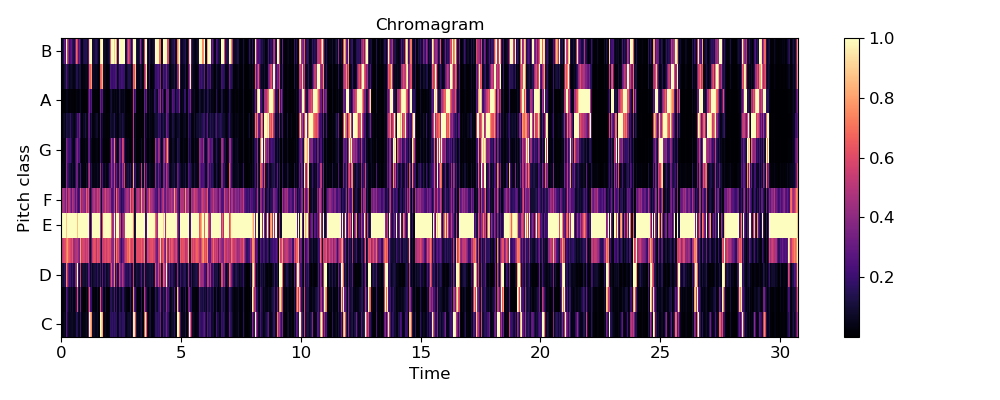librosa.feature.chroma_stft¶
-
librosa.feature.chroma_stft(y=None, sr=22050, S=None, norm=inf, n_fft=2048, hop_length=512, tuning=None, **kwargs)[source]¶ Compute a chromagram from a waveform or power spectrogram.
This implementation is derived from chromagram_E [1]
[1] Ellis, Daniel P.W. “Chroma feature analysis and synthesis” 2007/04/21 http://labrosa.ee.columbia.edu/matlab/chroma-ansyn/ Parameters: - y : np.ndarray [shape=(n,)] or None
audio time series
- sr : number > 0 [scalar]
sampling rate of y
- S : np.ndarray [shape=(d, t)] or None
power spectrogram
- norm : float or None
Column-wise normalization. See
librosa.util.normalizefor details.If None, no normalization is performed.
- n_fft : int > 0 [scalar]
FFT window size if provided y, sr instead of S
- hop_length : int > 0 [scalar]
hop length if provided y, sr instead of S
- tuning : float in [-0.5, 0.5) [scalar] or None.
Deviation from A440 tuning in fractional bins (cents). If None, it is automatically estimated.
- kwargs : additional keyword arguments
Arguments to parameterize chroma filters. See
librosa.filters.chromafor details.
Returns: - chromagram : np.ndarray [shape=(n_chroma, t)]
Normalized energy for each chroma bin at each frame.
See also
librosa.filters.chroma- Chroma filter bank construction
librosa.util.normalize- Vector normalization
Examples
>>> y, sr = librosa.load(librosa.util.example_audio_file()) >>> librosa.feature.chroma_stft(y=y, sr=sr) array([[ 0.974, 0.881, ..., 0.925, 1. ], [ 1. , 0.841, ..., 0.882, 0.878], ..., [ 0.658, 0.985, ..., 0.878, 0.764], [ 0.969, 0.92 , ..., 0.974, 0.915]])
Use an energy (magnitude) spectrum instead of power spectrogram
>>> S = np.abs(librosa.stft(y)) >>> chroma = librosa.feature.chroma_stft(S=S, sr=sr) >>> chroma array([[ 0.884, 0.91 , ..., 0.861, 0.858], [ 0.963, 0.785, ..., 0.968, 0.896], ..., [ 0.871, 1. , ..., 0.928, 0.829], [ 1. , 0.982, ..., 0.93 , 0.878]])
Use a pre-computed power spectrogram with a larger frame
>>> S = np.abs(librosa.stft(y, n_fft=4096))**2 >>> chroma = librosa.feature.chroma_stft(S=S, sr=sr) >>> chroma array([[ 0.685, 0.477, ..., 0.961, 0.986], [ 0.674, 0.452, ..., 0.952, 0.926], ..., [ 0.844, 0.575, ..., 0.934, 0.869], [ 0.793, 0.663, ..., 0.964, 0.972]])
>>> import matplotlib.pyplot as plt >>> plt.figure(figsize=(10, 4)) >>> librosa.display.specshow(chroma, y_axis='chroma', x_axis='time') >>> plt.colorbar() >>> plt.title('Chromagram') >>> plt.tight_layout()
